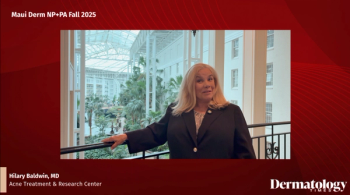
- Dermatology Times, February 2020 (Vol. 41, No. 2)
- Volume 41
- Issue 2
Topical minocycline shows potential for effective papulopustular rosacea treatment
Hovione recently published results of a phase 2b study showed a topical gel formulation of 1% and 3% minocycline proved to be an effective and safe treatment for papulopustular rosacea.
Recently published results from a phase 2b study demonstrated the therapeutic efficacy of a novel topical minocycline gel (HY01, Hovione) on patients with papulopustular rosacea (PPR).1 The results are significant, because it could potentially lead to a topical alternative to oral minocycline or oral doxycycline, for reducing inflammatory facial lesions in papulopustular rosacea, according to the authors.
Minocycline has been proven to be an effective treatment for PPR in an oral formulation; however, oral minocycline carries risk of side effects, says George Macgrath, M.D., medical director at Hovione, which sponsored the study. A topical option may concentrate the drug at the site of action, while decreasing systemic exposure substantially and may lead to fewer side effects, write the authors of the phase 2 study, which was published online January 6, 2020, in the British Journal of Dermatology.
“Minocycline is an oral antibiotic that's been used in both acne and rosacea effectively, and the new formulation now takes this oral pill and puts it into a gel that can be applied to the face. And because, orally, minocycline is effective in rosacea, there was a good chance it might also be effective topically,” says Zoe Diana Draelos, M.D., High Point, NC, who was an investigator and author of the study.
The phase 2 study was a double-masked, parallel group, randomized, multicenter, vehicle-controlled trial that enrolled 270 patients with papulopustular rosacea located in 26 sites across the United States.
Researchers compared the therapeutic efficacy among patients receiving 1% minocycline gel (n=92), 3% minocycline gel (n=96) or vehicle (n=82) applied to the face once nightly for 12 weeks. The primary endpoint was the mean decrease in inflammatory lesion count at week 12. The secondary endpoint was measured by the number of patients achieving “clear” or “almost clear” and a 2-grade improvement on the Investigator Global Assessment (IGA) and IGAe (including erythema) scales.
At baseline, the mean lesion count among patients was 24.6 in the 1% minocycline arm, 25.1 in the 3% minocycline arm, and 24.3 in the vehicle arm. Mean decrease in lesion counts were significantly higher in the 1% and 3% arms (12.64, p=0.0147, 95% CI -7.930-0.871 and 13.09, p=0.0073, 95% CI -8.319 to -1.310) compared with the vehicle arm (7.93). At four weeks following the completion of the study, patients in the 3% arm maintained a significant reduction in inflammatory lesions compared with vehicle.
Additionally, the study met its secondary endpoint with 38.9% of subjects achieving IGA success in the 1% minocycline arm (p=0.34, OR 1.396 and OR 95% CI 0.708 to 2.751 vs. vehicle), 46.2% in the 3% arm (p=0.04, OR 2.028 and OR 95% CI 1.040 to 3.952 vs. vehicle) and 30.8% in the vehicle group. A significantly greater number of patients in the 3% arm achieved success at week 9, which persisted through week 12, according to the study. The 3% arm also achieved a greater reduction in erythema at week 12. More than half of the patients reported satisfaction with the product in both treatment groups (72.3% and 69.9% in the 1% and 3% arms, respectively).
The results of the study demonstrate that topical minocycline is safe, well tolerated and potentially efficacious, the authors note. This could lead to an alternative option to oral doxycycline and oral minocycline with potentially fewer side effects, they add.
Up next for Hovione: Based on this phase 2 data, the company announced plans to move into its MARS-2 and MARS-3 (Minocycline Against Rosacea Study) phase 3 trials to further investigate efficacy of 3% minocycline gel. The trials will enroll 750 patients to assess absolute reduction of inflammatory lesions at week 12 compared with baseline and clearance on the IGA scale, according to a company press release.2 If results from the phase 3 trials can replicate the clinically significant improvements observed in the phase 2 study, the drug will move toward FDA marketing approval, the company says.
“We don't really have a good treatment for rosacea in all patients who experience the disease. So, the addition of topical minocycline offers a treatment alternative dermatologists can use in treating rosacea,” Dr. Draelos tells Dermatology Times.
References:
1. Webster G, Draelos ZD, Graber E, et al. A Multicenter, Randomized, Double-Masked, Parallel Group, Vehicle-Controlled Phase 2b Study to evaluate the safety and efficacy of 1% and 3% topical Minocycline Gel in patients with Papulopustular Rosacea. Br J Dermatol. 2020.
2. Hovione announces successful end-of-phase 2 meeting with the FDA and outlines phase 3 program for minocycline topical gel. Hovione. https://www.hovione.com/press-room/press-release/hovione-announces-successful-end-phase-2-meeting-fda-and-outlines-phase-3. Published September 20, 2019. Accessed January 21, 2020.
Articles in this issue
almost 6 years ago
Gene expression profile testing aids skin cancer managementalmost 6 years ago
How to diagnose rosacea in skin of color patientsalmost 6 years ago
Rosacea commonly underdiagnosedalmost 6 years ago
Technology targets non-genital wartsalmost 6 years ago
Can sweat shed a light on disease severity in atopic dermatitis?almost 6 years ago
Adjunctive platelet-rich plasma may improve acne scarsalmost 6 years ago
An investigational drug for keloidsalmost 6 years ago
Study supports evidence on indoor tanning riskalmost 6 years ago
Nano-pulse stimulation promising for skin lesionsalmost 6 years ago
Mind-body therapies effective for skin disordersNewsletter
Like what you’re reading? Subscribe to Dermatology Times for weekly updates on therapies, innovations, and real-world practice tips.

















